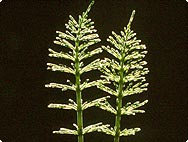
Equisetum arvense L.
Horsetail

History
The Horsetail descends from a prehistoric plant which covered entire forests during the Palaeozoic era 400 million years ago. This plant is a reminder of prehistoric times, when plants did not yet possess the ability to put out blossoms, a time when plants had a more primeval relationship to the mineral world, to water and to light.The generic term, Equisetum, stems from the Latin word equus meaning “horse“ and seta meaning “bristle “ or “hair“, i.e. horsetail. The term also comes from the Greek word hippo-uris, which has the same meaning. The species name, arvensis, denotes “field“ or “arable land“ and describes the plant’s location. If Horsetail is cremated carefully in a bowl, a delicate skeleton of ash remains which comprises almost pure silicic acid. This ash was once used to polish pewterware, which is why the plant is also known as “Pewterwort” and “Scouring rush”.Dioscorides described “hippo-uris” as a diuretic and an astringent; he also claimed that it stems the flow of blood in the uterus, soothes coughs and stanches bleeding wounds. Rev. Kneipp believed the plant to be indispensable to stop haemorrhaging and the spitting of blood. “Kobert-Kühnsche’s Silicic Tea”, which was highly regarded as a remedy for tuberculosis, contained six parts Knotweed, two parts Hempnettle and three parts Horsetail.

Botanical characteristics
Horsetail has a perennial root-stock and rhizome which can extend to 2 metres below ground. Two kinds of annual stems are produced from this root-stock: fertile and barren. The fertile stem appears after the snow thaws. This pencil-thick fruiting stem is unbranched and grows to a height of around 15 cm; it is pale brown to reddish in colour. The stems bear a characteristic brownish-coloured, terminal cone-shaped catkins containing whorls of closely packed peltae on which the sporophylls are to be found. At the nodes or joints of the stem, sheathes are to be found which can grow to a length of up to 2 cm and bear between six to twelve blackish-brown teeth or tips. As soon as the fertile stem withers, a pale green, barren frond appears in the same place, which can grow to a height of 40 cm. Unlike the fruiting stem, whorls of four or five-winged side branches rise from the internodules of the barren stem. The barren stem is furrowed and rough on the surface, this roughness is due to deposits of silicic acid (both fluid and crystallised) inside the stem. The plant spores from March to April.

Habitat
Horsetails are to be found throughout Europe, Asia and North America, from the warm zones right up to the Arctic. Of all the various types of Equisetum, this genus is the most widely met with; it is a ruderal plant, inhabiting sandy soil containing clay. In wet or damp areas, it is possible to find E. arvense growing next to E. palustre (“swamp horsetail”). E. arvense is identified by the first internodule on the plant’s branchlet, which is longer than the sheath on the shoot. It is very important to identify Horsetail correctly, since other species can contain a fungus (Ustilago equiseti) which can cause food poisoning. In North America and in Russia, the species E. hyemale (“Winter Horsetail”) is used for medicinal purposes. This plant has no leaves and grows to a height of up to 1.3 metres.

Preparation
A.Vogel/Bioforce makes use of the barren stems of the Horsetail which are carefully identified before they are collected in the wild. The plant is collected between the months of May and June, when the silicic acid contained in the stems are still in a soluble stage, thus making it easier to assimilate. Shortly after harvesting, the stems are cut up finely and macerated in alcohol to produce a mother tincture.
A.Vogel Blog – Natural and Healthy
Inspiration for a healthy life!
HERBAMARE SOUP-ER SOUPS!
DOWNLOAD YOUR FREE RECIPE BOOKLET!
8 healthy, hearty and delicious homemade soups.
Supporting a healthier happier you
“Nature is just about the best thing we’ve got!“
Alfred Vogel's guide to leading a healthy and happy life
Healthy & nutritious dinner ideas
Get new recipes in your inbox every month. Sign up now